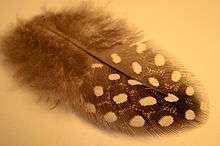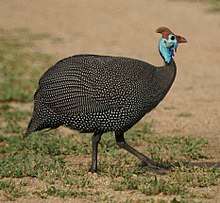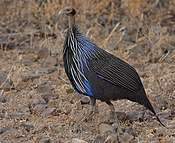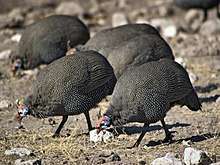Guineafowl
Guineafowl (/ˈɡɪnifaʊl/; sometimes called "pet speckled hens" or "original fowl") are birds of the family Numididae in the order Galliformes. They are endemic to Africa and rank among the oldest of the gallinaceous birds. Phylogenetically, they branched off from the core Galliformes after the Cracidae (chachalacas, guans, and curassows) and before the Odontophoridae (New World quail). An Eocene fossil lineage Telecrex has been associated with guineafowl; Telecrex inhabited Mongolia, and may have given rise to the oldest of the true Phasianids, such as blood pheasants and eared pheasants, which evolved into high-altitude montane-adapted species with the rise of the Tibetan Plateau. While modern guineafowl species are endemic to Africa, the helmeted guineafowl has been introduced as a domesticated bird widely elsewhere.[1]

| Guineafowl | |
|---|---|
.jpg) | |
| Helmeted guineafowl (Numida meleagris) | |
| Scientific classification | |
| Kingdom: | Animalia |
| Phylum: | Chordata |
| Class: | Aves |
| Order: | Galliformes |
| Superfamily: | Phasianoidea |
| Family: | Numididae Longchamps, 1842 |
| Genera | |
Taxonomy and systematics
This is a list of guineafowl species, presented in taxonomic order.
| Image | Genus | Living Species |
|---|---|---|
 |
Agelastes Bonaparte, 1850 |
|
 | Numida Linnaeus, 1764 |
|
.jpg) | Guttera Wagler, 1832 |
|
 | Acryllium G.R. Gray, 1840 |
|
Description
The insect- and seed-eating, ground-nesting birds of this family resemble partridges, but with featherless heads, though both members of the genus Guttera have a distinctive black crest, and the vulturine guineafowl has a downy brown patch on the nape. Most species of guineafowl have a dark grey or blackish plumage[3] with dense white spots, but both members of the genus Agelastes lack the spots. While several species are relatively well known, the plumed guineafowl and the two members of the genus Agelastes remain relatively poorly known. These large birds measure from 40–71 cm (16–28 inches) in length, and weigh 700–1600 grams or 1.5-3.5 pounds. Guinea hens weigh more than guinea cocks, possibly because of the larger reproductive organs in the female compared to the male guinea fowl. Also, the presence of relatively larger egg clusters in the dual purpose guinea hens may be a factor that contributes to the higher body weight of the guinea hens.[4]
Behavior and ecology
The species for which information is known are normally monogamous, mating for life, or are serially monogamous; however, occasional exceptions have been recorded for helmeted and Kenya crested guineafowl, which have been reported to be polygamous in captivity.[5] All guineafowl are social, and typically live in small groups or large flocks. Though they are monogamous, species of the least-derived genera Guttera, Agelastes and Acryllium tend toward social polyandry, a trait shared with other primitive galliformes like roul roul, and Congo peafowl.
Guineafowl travel behind herd animals and beneath monkey troops where they forage within manure and on items that have fallen to the understory from the canopy. Guineafowl play a pivotal role in the control of ticks, flies, locusts, scorpions and other invertebrates. They pluck maggots from carcasses and manure.
Wild guineafowl are strong flyers. Their breast muscles are dark, enabling them to sustain themselves in flight for considerable distances if hard-pressed. Grass and bush fires are a constant threat to these galliformes and flight is the most effective escape.
Some species of guineafowl, like the vulturine, may go without drinking water for extended periods, instead sourcing their moisture from their food. Young guineafowl (called keets) are very sensitive to weather, in particular cold temperatures.
Guinea hens are not known to be good mothers[6], but in the wild the guinea hen's mate (a guinea cock) may help tend the young keets during the day by keeping them warm and finding food. Sometimes more than one cock will help raise the young. It could be said that guinea fowl (hens and cocks together) make good parents. During warm weather the cock is unlikely to set on the keets during the night (leaving that duty to the hen), but may help the hen keep the keets warm at night when temperatures drop below freezing.
Guinea fowl may be trained to go into a coop (instead of roosting in trees) when very young. Once hatched and ready to leave the brooder (approx. 3 weeks), they may be enclosed in a coop for at least 3 days so they learn where "home" is. When guinea parents (who already roost in a coop) raise their own keets, the hen will set on them outdoors during the night, but then the parents will teach the keets to also go into the coop in the evenings at approximately 3 weeks of age.
Each sex has a different call which can be used to differentiate between female and male. [7] Unlike chickens (which generally do best with one rooster for a flock of hens[8]), guinea fowl do well with one cock for each hen.
Distribution and habitat
Guineafowl species are found across sub-Saharan Africa, some almost in the entire range, others more localized, such as the plumed guineafowl in west-central Africa and the vulturine guineafowl in north-east Africa. They live in semi-open habitats such as savanna or semideserts, while some, such as the black guineafowl, mainly inhabit forests. Some perch high on treetops.
The helmeted guinea fowl has been introduced in East Africa, the West Indies, the United States, Britain, and India, where it is raised as food or pets.[9]
Guineafowl as food
Guineafowl meat is drier and leaner than chicken meat and has a gamey flavour. It has marginally more protein than chicken or turkey, roughly half the fat of chicken and slightly fewer calories per gram.[10] Their eggs are substantially richer than those of chickens.[11]

 Head of a vulturine guineafowl
Head of a vulturine guineafowl
References
- Lever, Christopher (2005). Naturalised Birds of the World. London, United Kingdom: T & A D Poyser. pp. 24–26. ISBN 978-0-7136-7006-6.
- John Boyd's website Boyd, John (2007). "GALLIFORMES - Landfowl". Retrieved 30 December 2015.
- "Guinea Fowl - Missouri". Cub Creek Science and Animal Camp. Retrieved 2018-10-20.
- RossHeywood. "Penny the Silkie Bantam with her two foster Guinea Fowls". Rumble.
- (Madge and McGowan, p. 345–352)
- Contributor, Author : Countryside (2019-05-08). "Are Guinea Hens the Worst Moms of All?". Backyard Poultry. Retrieved 2019-11-20.
- "Guinea Hen: All You Need To Know (Complete Care Guide)". www.thehappychickencoop.com.
- "How many roosters can I have?from My Pet Chicken". My Pet Chicken. Retrieved 2019-11-20.
- "Guinea Fowl: Your Overlooked Backyard Buddy - Modern Farmer". modernfarmer.com. 15 October 2014. Retrieved 27 March 2018.
- USDA handbook #8 and circular #549, leclercq 1985
- "Archived copy" (PDF). Archived from the original (PDF) on 2015-07-01. Retrieved 2014-11-06.CS1 maint: archived copy as title (link)
Further reading
- Madge and McGowan, Pheasants, Partridges and Grouse. ISBN 0-7136-3966-0
- Martínez, I. (1994). "Family Numididae (Guineafowl)", p. 554–570 in; del Hoyo, J., Elliott, A. & Sargatal, J. eds. Handbook of the Birds of the World, Vol. 2. New World Vultures to Guineafowl. Lynx Edicions, Barcelona. ISBN 84-87334-15-6
External links
| Wikimedia Commons has media related to Numididae. |
- Guineafowl videos on the Internet Bird Collection
- SPPA article on Guinea Fowl Early Birds: Guinea Fowl by Dennis Headley

